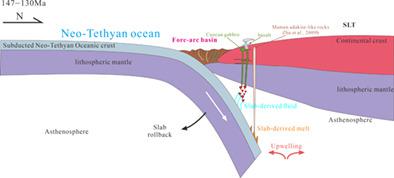当前位置:
X-MOL 学术
›
Geolog. J.
›
论文详情
Our official English website, www.x-mol.net, welcomes your feedback! (Note: you will need to create a separate account there.)
U–Pb zircon age and geochemistry of the Cuocun gabbro in the southern Lhasa Terrane: Implications for Early Cretaceous rollback of the Neo‐Tethyan oceanic slab
Geological Journal ( IF 1.8 ) Pub Date : 2020-09-30 , DOI: 10.1002/gj.3994 Qing He 1 , Xinghai Lang 1, 2 , Liang Li 1 , Cuihua Chen 1 , Xuhui Wang 1 , Yulin Deng 1 , Qing Yin 1 , Fuwei Xie 1 , Zongyao Yang 3 , Zhong Zhang 4 , Kai Jiang 4
Geological Journal ( IF 1.8 ) Pub Date : 2020-09-30 , DOI: 10.1002/gj.3994 Qing He 1 , Xinghai Lang 1, 2 , Liang Li 1 , Cuihua Chen 1 , Xuhui Wang 1 , Yulin Deng 1 , Qing Yin 1 , Fuwei Xie 1 , Zongyao Yang 3 , Zhong Zhang 4 , Kai Jiang 4
Affiliation

|
The geodynamic mechanism of the Early Cretaceous magmatic rocks in the southern Lhasa Terrane remains controversial. To constrain the Early Cretaceous petrogenesis and tectonic evolution of the Neo‐Tethyan oceanic slab, we have undertaken zircon U–Pb dating, whole‐rock major and trace element analyses, and Sr–Nd–Pb–Hf isotopic studies of the Cuocun gabbro from the southern Lhasa Terrane. The zircon U–Pb dating yielded an Early Cretaceous crystallization age of 146.9 ± 0.6 Ma (MSWD = 0.77, 2σ). The Cuocun gabbro is enriched in large‐ion lithophile elements (e.g., Rb, Sr, and Ba) and depleted in high‐field‐strength elements (e.g., Nb, Ta, and Ti). The initial 87Sr/86Sr value are low (0.70361–0.70460), εNd(t) and εHf(t) values are high and positive (from +5.1 to +6.6 and from +11.0 to 17.0, respectively), and Pb isotope specific value are homogeneous (initial 206Pb/204Pb = 18.163–18.457, 207Pb/204Pb = 15.541–15.632, and 208Pb/204Pb = 38.262–38.673). The gabbro originated from the partial melting of a depleted mantle wedge that had reacted with slab‐derived fluids, and the ascending magmas underwent fractional crystallization without significant crustal contamination. Combining our data with those from previous studies of Early Cretaceous magmatism in the southern Lhasa Terrane, we suggest that the Early Cretaceous magmatic rocks (147–130 Ma) in the southern Lhasa Terrane were generated within a continental marginal arc setting related to the rollback of the northwards subducting Neo‐Tethyan oceanic slab.
中文翻译:

拉萨地带南部的Cuocun gabbro的U–Pb锆石年龄和地球化学:对新特提斯洋板块早白垩世回滚的影响
拉萨地带南部早期白垩纪岩浆岩的地球动力学机制仍存在争议。为了限制新特提斯洋洋板块的早白垩世成岩作用和构造演化,我们进行了锆石U–Pb定年,全岩主元素和微量元素分析,以及对Cuocun gabbro的Sr–Nd–Pb–Hf同位素研究。南部的拉萨地带。锆石U–Pb测年产生的白垩纪早期结晶年龄为146.9±0.6 Ma(MSWD = 0.77,2σ)。Cuocun gabbro富含大离子的嗜石元素(如Rb,Sr和Ba),而缺乏高场强元素(如Nb,Ta和Ti)。初始87 SR / 86的SR值是低的(0.70361-0.70460),ε的Nd(吨)和ε的Hf(吨)值高和阳性(从5.1到6.6,并从11.0到17.0,分别地),和Pb同位素特定值是同质的(初始206的Pb / 204 PB = 18.163-18.457,207的Pb / 204 Pb = 15.541–15.632和208 Pb / 204铅= 38.262–38.673)。辉长岩起源于贫化的地幔楔的部分融化,而地幔楔与板状流体反应后,上升的岩浆经历了部分结晶而没有明显的地壳污染。将我们的数据与以前对拉萨地带南部白垩纪岩浆作用的研究相结合,我们认为拉萨地带南部的白垩纪岩浆岩(147-130 Ma)是在与陆缘回滚有关的大陆边缘弧环境中产生的。向北俯冲的新特提斯洋洋板块。
更新日期:2020-09-30
中文翻译:

拉萨地带南部的Cuocun gabbro的U–Pb锆石年龄和地球化学:对新特提斯洋板块早白垩世回滚的影响
拉萨地带南部早期白垩纪岩浆岩的地球动力学机制仍存在争议。为了限制新特提斯洋洋板块的早白垩世成岩作用和构造演化,我们进行了锆石U–Pb定年,全岩主元素和微量元素分析,以及对Cuocun gabbro的Sr–Nd–Pb–Hf同位素研究。南部的拉萨地带。锆石U–Pb测年产生的白垩纪早期结晶年龄为146.9±0.6 Ma(MSWD = 0.77,2σ)。Cuocun gabbro富含大离子的嗜石元素(如Rb,Sr和Ba),而缺乏高场强元素(如Nb,Ta和Ti)。初始87 SR / 86的SR值是低的(0.70361-0.70460),ε的Nd(吨)和ε的Hf(吨)值高和阳性(从5.1到6.6,并从11.0到17.0,分别地),和Pb同位素特定值是同质的(初始206的Pb / 204 PB = 18.163-18.457,207的Pb / 204 Pb = 15.541–15.632和208 Pb / 204铅= 38.262–38.673)。辉长岩起源于贫化的地幔楔的部分融化,而地幔楔与板状流体反应后,上升的岩浆经历了部分结晶而没有明显的地壳污染。将我们的数据与以前对拉萨地带南部白垩纪岩浆作用的研究相结合,我们认为拉萨地带南部的白垩纪岩浆岩(147-130 Ma)是在与陆缘回滚有关的大陆边缘弧环境中产生的。向北俯冲的新特提斯洋洋板块。

























 京公网安备 11010802027423号
京公网安备 11010802027423号